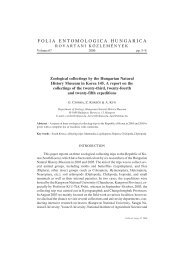History of the Herpetological Collection of the ... - Korsós Zoltán
History of the Herpetological Collection of the ... - Korsós Zoltán
History of the Herpetological Collection of the ... - Korsós Zoltán
Create successful ePaper yourself
Turn your PDF publications into a flip-book with our unique Google optimized e-Paper software.
68 Z. Korsós<br />
FEJÉRVÁRYNÉ became a curator in 1939, participated in <strong>the</strong> faunistical exploration <strong>of</strong><br />
Transylvania reconnected to Hungary in 1940; and she published her results in 1944<br />
(FEJÉRVÁRY-LÁNGH 1944). The zoological researchers had <strong>the</strong>ir first opportunity to do research<br />
in Transylvania in 1941–42, and <strong>the</strong> regular research started in 1943. The collectors<br />
were IRMA ALLODIATORIS,JÁNOS BALOGH,ENDRE DUDICH,GYULA ÉHIK,ANTAL GEBHARDT,<br />
ADORJÁN KESSELYÁK, GÁBOR KOLOSVÁRY, IMRE LOKSA, MIKLÓS and LÁSZLÓ MÓCZÁR,<br />
SÁNDOR PONGRÁCZ, MIHÁLY ROTARIDES, LAJOS SOÓS, JÓZSEF SZENT-IVÁNY and VILMOS<br />
SZÉKESSY. The number <strong>of</strong> specimens in <strong>the</strong> material is unfortunately unknown.<br />
During <strong>the</strong> war, both <strong>of</strong> her (grown-up) children were in <strong>the</strong> West, so she had to endure<br />
<strong>the</strong> siege <strong>of</strong> Budapest alone. In 1945, her apartment was bombed, so she moved into<br />
<strong>the</strong> department’s building in Baross street. She was entrusted with <strong>the</strong> task to reorganise<br />
<strong>the</strong> collections, which were moved into <strong>the</strong> basement after <strong>the</strong> war, and to watch over <strong>the</strong><br />
exhibitions. These tasks ate up all <strong>of</strong> her time, but she successfully finished <strong>the</strong>m; even<br />
though, perhaps for her aristocratic relationships, she was dismissed from <strong>the</strong> museum in<br />
1951. On 13 th <strong>of</strong> October 1956, 10 days before <strong>the</strong> Hungarian revolution, she flew to her<br />
daughter to Switzerland with <strong>of</strong>ficial papers, and one year later, she went on to her son to<br />
Venezuela. After 8 years, she returned to Europe and donated <strong>the</strong> result <strong>of</strong> her South American<br />
collections to <strong>the</strong> Natural <strong>History</strong> Museum <strong>of</strong> Lugano, Switzerland. She never came to<br />
Hungary again, though she welcomed Hungarian visitors in her home. In 1983, she flew<br />
back again to Venezuela, and spent <strong>the</strong> rest <strong>of</strong> her life with her family <strong>the</strong>re. She died in<br />
1988 at <strong>the</strong> age <strong>of</strong> 90; her grave is in Maracaibo (DELY 1998a, b).<br />
On 1 st <strong>of</strong> July 1950, OLIVÉR GYÖRGY DELY was appointed in <strong>the</strong> museum next to<br />
FEJÉRVÁRYNÉ, and it was soon in 1951 when he took over <strong>the</strong> management <strong>of</strong> <strong>the</strong> collection.<br />
(1900–1974) medical biochemist – who worked at <strong>the</strong><br />
Butantan Institute in São Paulo since 1940 – became familiar with <strong>the</strong> herpetological collection<br />
in <strong>the</strong> time <strong>of</strong> FEJÉRVÁRYNÉ. In his herpetological works, he discussed <strong>the</strong> venom<br />
activity <strong>of</strong> <strong>the</strong> Bothrops-species, but he became world-famous for his medical, physical-chemical,<br />
and colloid-chemical investigations. Because <strong>of</strong> his good relationship with<br />
FEJÉRVÁRYNÉ and later also with DELY, he donated a Brazilian snake collection to <strong>the</strong> museum,<br />
which was unfortunately destroyed in 1956. In those rare occasions when he came<br />
home to Budapest, he never missed a visit to <strong>the</strong> museum and to discuss herpetological<br />
questions with DELY. He died in Brazil in 1974, and he is also buried <strong>the</strong>re (DELY 1975a).<br />
Between <strong>the</strong> two World Wars, under <strong>the</strong> general directorship <strong>of</strong> SÁNDOR PONGRÁCZ<br />
(1887–1945), detailed guides to <strong>the</strong> material exhibited in <strong>the</strong> building <strong>of</strong> <strong>the</strong> National Museum<br />
were written (PONGRÁCZ 1937a, b, 1942). We can find two photographs about <strong>the</strong><br />
systematic part <strong>of</strong> <strong>the</strong> amphibian and reptile exhibition (Figs 24–25). But in <strong>the</strong> famous<br />
Africa-room on <strong>the</strong> second floor, <strong>the</strong>re were beautifully prepared natural dioramas, with<br />
specimens <strong>of</strong> e.g. <strong>the</strong> Nile Crocodile (Crocodylus niloticus) (Figs 26–27) and <strong>the</strong> African<br />
Spurred Tortoise (Geochelone sulcata) exhibited. The systematic collection <strong>of</strong> reptiles was<br />
located on <strong>the</strong> third floor. OSZKÁR VOJNICH’s famous hunting trophy collection (put on<br />
permanent deposit by his heir, MIKLÓS VOJNITS) was since 1930 located in Baross street,<br />
in <strong>the</strong> director general’s room, except for <strong>the</strong> giant Indian Python (Python molurus) shot<br />
Annls hist.-nat. Mus. natn. hung. 100, 2008




